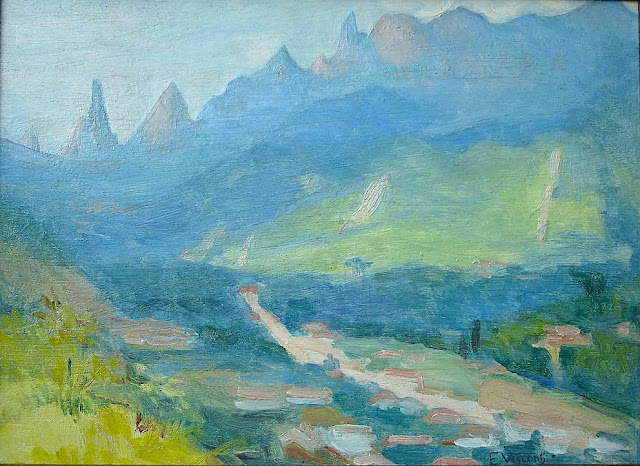
JORGE RODRIGUEZ-GERADA (bn.1 966)
Mount Denali (6, 190 m - 20, 310 ft)
United States of America (Alaska)
La montagne
Denali (également connu sous le nom de mont McKinley,)) est le plus haut sommet de montagne en Amérique du Nord, avec une altitude au sommet de 6 190 m - 20 310 pieds au-dessus du niveau de la mer. Denali est le troisième sommet le plus important et le troisième le plus isolé après le mont Everest et l'Aconcagua. Denali est l'un des sept sommets, qui comprend les plus hautes montagnes de chacun des sept continents. Les atteindre tous est considéré comme un défi d'alpinisme, réalisé pour la première fois le 30 avril 1985 par Richard Bass.
Situé dans la chaîne de l'Alaska à l'intérieur de l'État américain de l'Alaska, Denali est la pièce maîtresse du parc national et de la réserve de Denali.
Denali a deux sommets importants: le sommet sud est le plus élevé, alors que le sommet nord a une altitude de 19 470 pieds (5 934 m). Le sommet nord est parfois compté comme un pic distinct et parfois non; il est rarement escaladé, sauf par ceux qui font des voies sur le versant nord du massif.
Cinq grands glaciers coulent des pentes de la montagne. Le glacier Peters se trouve sur le côté nord-ouest du massif, tandis que le glacier Muldrow tombe de ses pentes nord-est. Juste à l'est du Muldrow, et jouxtant le côté est du massif, se trouve le glacier Traleika. Le glacier Ruth se trouve au sud-est de la montagne et le glacier Kahiltna mène au côté sud-ouest de la montagne. Avec une longueur de 44 mi (71 km), le glacier Kahiltna est le plus long glacier de la chaîne de l'Alaska.
Les Koyukon Athabaskans qui habitent la région autour de la montagne ont pendant des siècles appelé le pic Dinale ou Denali. Il a été brièvement appelé Densmore's Mountain à la fin des années 1880 et au début des années 1890 en l'honneur de Frank Densmore, un prospecteur de l'Alaska qui fut le premier Européen à atteindre la base de la montagne.
En 1896, un chercheur d'or l'a nommé McKinley en soutien au candidat à la présidence de l'époque, William McKinley, t devenu président l'année suivante. Les États-Unis ont officiellement reconnu le nom de Mount McKinley après que le président Wilson a signé le Mount McKinley National Park Act du 26 février 1917.
En 1965, Lyndon B. Johnson a déclaré les sommets nord et sud de la montagne les "Churchill Peaks", en l'honneur de l'homme d'État britannique Winston Churchill. Le Conseil des noms géographiques de l'Alaska a changé le nom de la montagne en Denali en 1975, comme on l'appelle localement.
Le 30 août 2015, juste avant une visite présidentielle en Alaska, l'administration de Barack Obama a annoncé que le nom Denali serait rétabli conformément à la désignation de l'Alaska Geographic Board.
L'artiste
Jorge Rodríguez-Gerada est un artiste contemporain cubano-américain. Né à Cuba le 5 février 1966 et élevé aux États-Unis. Il crée principalement des œuvres dans des espaces urbains à grande échelle. Il a été membre fondateur du mouvement de brouillage culturel new-yorkais du début des années 1990, travaillant d'abord avec le groupe "Artfux" et plus tard avec le "Cicada Corps of Artists". Au cours de cette période, il a également lancé des interventions sur les panneaux d'affichage et la publicité publique. En 1997, il a commencé à s'orienter vers le travail en solo. En 2002, Rodríguez-Gerada a déménagé à Barcelone où il s'est concentré sur les dessins au fusain éphémères à grande échelle, qui composent sa série Identity. Il a ensuite développé la Série Terrestre ; des terrassements éphémères si vastes qu'ils sont visibles de l'espace. D'autres projets en cours incluent la série Identity Composite et des œuvres d'art plus petites qu'il appelle Fragment Series, Urban Analogies et Memorylythics. Depuis 2009, il organise le festival annuel AvantGuard Urbano ; un petit festival d'art urbain avec de grands noms, qui s'est tenu à Tudela, en Navarre, dans le nord de l'Espagne. Il participe également à de nombreux salons et expositions.
2023 - Wandering Vertexes ....
Errant au-dessus des Sommets Silencieux...
Un blog de Francis Rousseau
%20-%20The%20MOnt%20Blanc%20%20seen%20from%20italy%20%20oil%20on%20canvas,%20100%20x%20140-CP%20.jpg)
-%20K2%20%20in%201909.jpg)
-%20Nuptse%20%20Himalaya%202011%20%20acrylic%20on%20paper-%20John%20Mitchell.jpg)

%20-%20The%20Anva%CC%84r-i%20Suhayli%CC%84%20or%20Lights%20of%20Canopus-%201847-The%20Walters%20Art%20Museum15.jpg)
%20alta-montagna(monte%20binaco%20detail.jpg)








